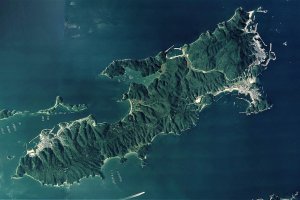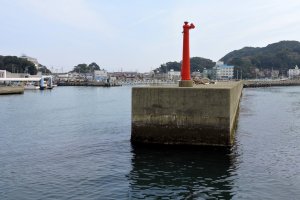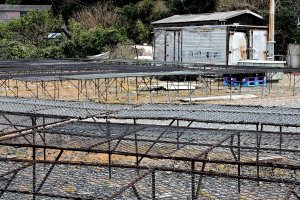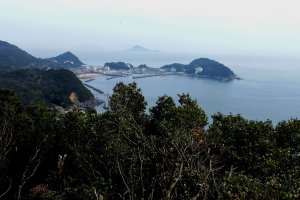Islands in Japan have a special atmosphere that I love. Something about the isolation and the close interaction with nature makes them feel very different from the mainland. You can sense it even in popular tourist islands like Miyajima, but Tōshi Island in Ise-Shima National Park seems untouched by tourism. It is unstaged and natural, and its culture is built around harvesting food from the sea.

The Shima area is one of just three ‘miketsu-kuni’ in Japan. Miketsu-kuni is an area which produces food offerings for Shinto and the Imperial Court since ancient times. The other miketsu-kuni are Wakasa in Fukui, and Awajishima. Nearby Ise Shrine where the goddess Amaterasu, ancestor of the Emperor is worshiped, is Japan’s at the top of Shinto hierarchy. The history and tradition of this place increases my interest in it.
I took the 20 minute ferry ride from Toba to the port on Tōshi Island. As we pulled into the docks, one of the first things I noticed was people cooking black seaweed in huge vats. I was surprised to learn that it was wakame. When the seaweed is plunged into boiling water it changes color to the beautiful deep green I am familiar with. Cooking it briefly ensures it won’t deteriorate too quickly on its journey through the market and into your bowl of miso soup or salad. The wakame harvest takes place in March every year.

There are boats everywhere, and on land there are piles of rope, nets, and buoys. It is rough and untidy and definitely real. Walking away from the waterfront we encounter fields full of black net stretched over frames. These are for drying shirasu, small fish we call whitebait in my home country. Everywhere you look you can see the symbol ‘八’. This is the symbol of Hachiman Shrine where the island people pray for protection and prosperity.
Our first destination is a brand new observation deck built on a ley line between Ise Shrine and Mt Fuji. After a rather steep climb we are rewarded with beautiful views over the ocean. On a clear day you can see Mt Fuji from here, but the March sky was too hazy. My friend told me the observation deck was recently used for yoga. It would be the perfect place for a sunrise yoga session!

Next we walk past more of the black nets, but these are covered with shirasu. Islanders are turning the fish by hand to ensure even drying. We pass piles of terracotta octopus pots, and visit Hachiman Shrine on the way. We stop in at the fish market where an auction is taking place. Buyers inspect the fish, then write their bids on pieces of paper. At the auctioneer’s signal they show their bids, and the highest bidder gets the fish. They move past the tanks of fish very fast.

For me, part of the charm of places like this is the worn, run-down appearance of everything. I exclaim over the ‘wabi-sabi’ but that makes my Japanese companions laugh, so perhaps I don’t understand the concept of wabi-sabi properly.

We leave the waterfront and wander along narrow alleyways till we find a tiny restaurant named Lonk where we sit down at a large table that almost fills the room, and eat a lunch of local seafood. I linger over the delicious food, trying to savor every bite, and we are almost late for the ferry back to the mainland.
I’m so glad I went to Tōshi Island. It’s the kind of place where you can enjoy wandering around exploring for hours, but there’s not much English. I had the advantage of being with some Japanese friends who spoke English, but if you don’t want to wander around by yourself, you can join a tour that takes visitors to Tōshi Island, hosted by the Kaito Yumin Club.

You might like
 14
14
Tōshijima's Sea Harvest
Tōshijima is the largest of several islands that lie just offshore in Ise-Shima. The island's history and culture are inti..































